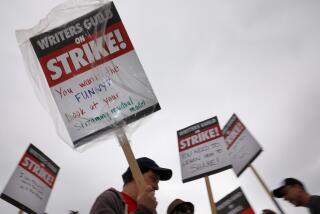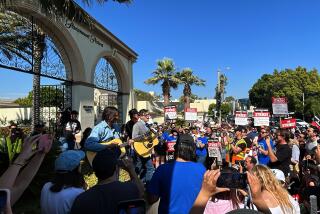Battle Royalty
- Share via
Last week, top executives from four popular online radio services sent a letter to every member of Congress, warning that new royalty rates for online radio broadcasters “will cause immediate bankruptcy of the majority of the Internet radio industry” on July 15, the day they take effect.
The new royalties themselves don’t sound like muchfor an all-music station, less than 1.8 cents per listener per hour this year, rising to 3 cents in 2010but they represent a stunning increase for small and non-commercial webcasters, as well as firms offering a wide array of customized channels.
Opponents of the new rates have trotted out a number of horror stories and absurdities to challenge the copyright royalty judges’ reasoning. SoundExchange, which represents labels and performers, collected about $18 million in webcasting royalties last year, and a total of $53 million since 1998. But the new minimum fee of $500 per channel would force three webcasters that offer thousands of customized channelsRealNetworks, Yahoo and Pandorato cough up $1.15 billion per year, according to attorneys for the companies.
Meanwhile, the judges’ decision to charge all commercial webcasters a flat fee per song performed, with the new rates applying retroactively to last year’s transmissions, spells doom for some popular stations with limited advertising sales. Pressured by Congress, SoundExchange negotiated a deal with small commercial webcasters in late 2002 that allowed them to pay as little as 10% of their gross revenue in royalties, with a minimum of $2,000 a year. Although the deal expired in 2005, small webcasters continued to pay a percentage of their revenues while waiting for new rates to be set. Mark Lam, chief executive of webcasting aggregator Live365, said a handful of webcasters on his network who had paid the minimum now owe tens or even hundreds of thousands of dollars in royalties for 2006 and the first half of 2007. If forced to pay, they could lose their homes, Lam said, adding, “It’s unfathomable.”
Truth be told, “unfathomable” doesn’t really apply to the webcasters’ situation because they’ve been through this kind of drama before. In 2002, a federal panel set royalty rates for webcasters at more than 2 cents per listener per hour for commercial, Web-only stations, retroactive to 1998. Although the Librarian of Congress later cut the rate in half, many webcasters still pulled the plug because they couldn’t afford to pay the fee. The online radio industry ran to Capitol Hill, persuading Congress that the expensive royalty-setting process had been unfair to small webcasters who couldn’t afford to plead their case. The result was the Small Webcaster Settlement Act, which opened the door for SoundExchange to strike the percentage-of-revenue arrangement with small commercial webcasters and offer a discounted set of fees for non-commercial stations.
The basic problems here include a royalty-setting process that promotes brinkmanship. Many labels and artists, particularly the independent ones not affiliated with the Recording Industry Assn. of America, see webcasters as critical alternatives to over-the-air stations, whose shrunken playlists leave little room for new or lesser-known artists. Unlike the major-label-dominated airwaves, 30% or more of the tunes heard on Internet stations are from indies. (That estimate is based on royalties collected by SoundExchange, so it almost certainly understates the difference between over-the-air playlists and online ones because small webcasters often fail to report what they play.) Yet negotiators for the labels have been reluctant to strike discounted royalty deals with small-fry webcasters because of the precedent they could setnot just for larger webcasters, but also for satellite and cable-TV music services.
It’s worth noting that two months after the Copyright Royalty Board set the new royalty rates, SoundExchange offered to extend the existing discounts for small webcasters (a move that may or may not spare the webcasters on Live365’s network, depending on the limit SoundExchange places on audience size). “Artists and labels are offering a below-market rate to subsidize small webcasters because Congress has made it clear that this is a policy it desires to advance, at least for the next few years. We look at it as artists and labels doing their part to help small operators get a stronger foothold,” SoundExchange executive director John Simson said.
In a recent interview, Simson said SoundExchange has also offered to extend the discounts enjoyed by non-commercial webcasters. SoundExchange’s main target is the limited number of large webcasters with strong advertising or subscriber revenues, such as AOL, Yahoo and RealNetworks. More than 80% of the royalties paid last year came from 10 webcasters, SoundExchange reported; by contrast, all small webcasters combined paid only 2% of those fees.
At the same time, there’s a fundamental philosophical difference between some webcasters (and their listeners), who feel they are entitled to play the songs they love online, and many in the music industry, who think webcasting should be open only to those who can afford to pay a certain level of royalties. Simson defends charging a $500 minimum even for amateurs and non-commercial webcasters, noting that fishermen and golfers spend more per year to pursue their hobbies. Ben Newhouse, editor of the online trade magazine RoyaltyWeek, noted that the 2006 royalty rates amount to about $6.50 per listener per year, based on a Bridge Ratings report that the average listener consumes more than 470 hours of Internet radio annually. “Cananyone objectively state it is unreasonable for copyright owners tocharge $6.49 for the right to broadcast 473.2 hours of music? $6.49 isa Happy Meal,” Newhouse wrote.
Clearly, with CD sales in free fall, the music industry’s longstanding interest in the promotional value of radio is giving way to its hunger for new revenue streams. Labels and artists are even pushing to collect royalties from over-the-air stations, which have long been exempted (they pay royalties only to songwriters).
Still, the industry has to be careful here because the new webcasting royalty rates would not only raise the barriers to entry but also rule out some business models. In particular, the new minimums are lethal to free webcasters such as Pandora, which use the unique capabilities of computers and the Web to match listeners with customized online channels. They improve radio programming by narrowcasting instead of broadcastingoffering multiple stations with niche appeal, rather than pitching more broadly palpable fare to the masses. Such services bring badly needed exposure to obscure genres and artists, overlooked releases and older material.
The biggest risk for the music industry is that the higher minimums and rising rates could trigger the kind of consolidation that has made over-the-air radio a no-fly zone for all but a fraction of the tracks released on CD. Such consolidation would almost certainly reduce the diversity of music online, which runs contrary to the needs of most artists and labels as well as the public’s interest. Look at Live365 as an example. According to spokesman Rod Hsiao, more than two-thirds of the songs played by the broadcasters aggregated there come from indie acts and record companies. That makes Live365 valuable to a broad swath of the music industry, even if it’s not especially helpful to the major record companies whose acts dominate commercial radio. But Live365, which paid $1.3 million in royalties last year, is looking at a revised bill of $4.7 million bill under the new rules. That’s more than 100% of the company’s radio-related revenues, Hsiao said, adding, “It would be better for us not to play music.” That doesn’t sound like a Happy Meal for anybody.
Jon Healey is a Times editorial writer; he runs the BitPlayer blog .
Send us your thoughts at opinionla@latimes.com.
More to Read
A cure for the common opinion
Get thought-provoking perspectives with our weekly newsletter.
You may occasionally receive promotional content from the Los Angeles Times.










